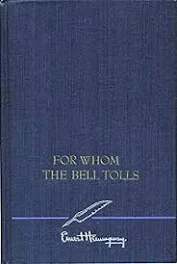For Whom the Bell Tolls by Ernest Hemingway 1940
Hemingway was born on July 21, 1899 in Oak Park, Illinois. He attended my alma mater, Oak Park-River Forest High School, and after graduation he became a journalist and drove an ambulance in Italy in WWI. He wrote his famous novels based on his own experiences, ‘The Sun Also Rises’ based on Paris in the 1920’s, ‘A Farewell to Arms’ based on his experiences in WWI, ‘For Whom the Bell Tolls’ based on his experiences in Spain during the Spanish Civil War, and ‘The Old Man and the Sea’ based on his life in Cuba and Key West. He won the Nobel Prize in 1954 and committed suicide by gunshot in Idaho in 1961, ending his life at 61 afflicted with depression treated with repeated electroshock treatments at both Mayo and in Sun Valley.
Hemingway’s life was in almost every respect ‘larger than life’ from his days in Paris with Gertrude Stein and F. Scott Fitzgerald to his war time adventures, his safaris, his plane crashes, his boat Pilar in Cuba, and his home in Key West. His need and appetite for adventure began to increasingly fall short of his physical and mental capacities, especially made evident in the late 1940’s and 1950’s as friends and colleagues began to die. His four marriages are further evidence of a questing spirit and failure to find peace. His father, a sister, and a brother all committed suicide.
‘For Whom the Bell Tolls’ is a magnificent book, paced perfectly and vividly written. It tells the story of Robert Jordan, a college English instructor in Montana who enlists in the International Brigade fighting Franco in Spain in the 1930’s. Jordan is a ‘dynamiter’, a skilled soldier who is sent to blow up a bridge that would limit the enemies of the Republic from bringing up troops and armor to oppose a major attack near Segovia. At the beginning of the book, Jordan connects with a band of guerillas in the mountains near the bridge. They are led by Pablo and his wife Pilar and are headquartered in a cave where Jordan meets Maria, a young girl whose head had been shaved by the Fascists who shot her parents for their Republican views. Jordan and Maria fall in love and have three amorous nights before the fateful day when the bridge is blown up and Jordan is killed.
Early on, the book moves slowly and at times feels bogged down by details but as the battle approaches, Hemingway’s skill in pacing becomes evident and the final 100 pages fly by. The tension is almost unbearable as Jordan blows the bridge and joins the guerillas in their escape attempt on horseback.
Hemingway’s boiled down style and goal to ‘write one great sentence’ are evident throughout the book. Here’s one magnificent passage in which Jordan, bedded down outside the cave in a spring snowfall, thinks about life and death in the night before he will blow up the bridge: “The night was clear and his head felt as clear and cold as the air. He smelled the odor of the pine boughs under him, the piney smell of the crushed needles and the sharper odor of the resinous sap from the cut limbs Pilar, he thought. Pilar and the smell of death. This is the smell I love. This and the fresh-cut clover, the crushed sage as you ride after cattle, wood-smoke and the burning leaves of autumn. That must be the odor of nostalgia, the smell of the smoke from the piles of raked leaves burning in the streets in the fall in Missoula. Which would you rather smell? Sweet grass the Indians used in their baskets? Smoked leather? The odor of the ground in the spring after rain? The smell of the sea as you walk through the gorse on a headland in Galicia? Or the wind from the land as you come in toward Cuba in the dark? That was the odor of the cactus flowers, mimosa, and the sea-grape shrubs. Or would you rather smell frying bacon in the morning when you are hungry? Or coffee in the morning? Or a Jonathan apple as you bit into it? Or a cider mill in the grinding, or bread fresh from the oven? You must be hungry, he thought, and he lay on his side and watched the entrance of the cvae in the light that the stars reflected from the snow.”
The title of the book comes from the John Donne poem from 1624 which begins “No man is an island, entire of itself” and ends with “And, therefore never send to know for whom the bell tolls; It tolls for thee.”
I read this book in a 1968 hard cover edition with Hemingway’s signature reproduced in silver on a blue background cover. A book of this stature should be read in that kind of volume. It’s a wonderful read and compares favorably to the rest of Hemingway’s wonderful novels. I think I’ve now read all of Hemingway’s fiction, and this one ranks near the top. His short stories featuring Nick Adams fishing and camping in Michigan’s Upper Peninsula and his love letter to Paris of the ’20’s, ‘A Moveable Feast’, though are still my favorites.
Through the wonders of Google, I learned that the book had been made into a movie in 1943 starring Gary Cooper and Ingrid Bergman. Netting 9 Oscar nominations, it won only one, for the supporting actress playing Pilar. A little noted member of the cast noted 17th in the Cast list was one Duncan Renaldo who played Lieutenant Berrendo, a Fascist officer who will be shot by Jordan moments before Jordan himself is killed. Renaldo was a childhood favorite of mine playing The Cisco Kid on television between 1950-1956. Little did I know then that that heroic Mexican cowboy had been born in Romania!



